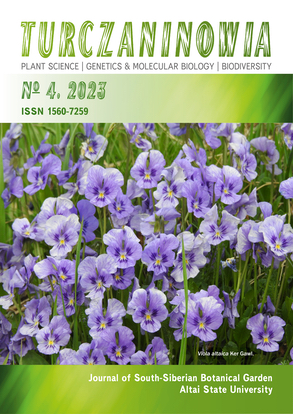Bacidina ferax – a new species for the lichen flora of the Middle European Russia
UDC 582.29(470.341)
Abstract
Bacidina ferax was described by Stefan Ekman in 2023, particularly basing on the collections from the North-East of the European Russia (Komi Republic). Herewith, B. ferax is reported for the first time for the Middle European Russia – from the Nizhny Novgorod Region. A complete morphological description, including the characters, distinguishing B. ferax from the related species, in Russian is given; its distribution range is characterized. The obtained results make a valuable contribution to the knowledge of the global distribution range of B. ferax. The specimens from Kerzhensky Nature Reserve are kept in the lichenological herbarium of the Komarov Botanical Institute (LE L, Saint- Petersburg), duplicate – in the herbarium of the Altai State University (ALTB, Barnaul).
Downloads
Metrics
References
Meyer B., Printzen C. 2000. Proposal for a standardized nomenclature and characterization of insoluble lichen pigments. Lichenologist 32(6): 571–583.
Turczaninowia is a golden publisher, as we allow self-archiving, but most importantly we are fully transparent about your rights.
Authors may present and discuss their findings ahead of publication: at biological or scientific conferences, on preprint servers, in public databases, and in blogs, wikis, tweets, and other informal communication channels.
Turczaninowia allows authors to deposit manuscripts (currently under review or those for intended submission to Turczaninowia) in non-commercial, pre-print servers such as ArXiv.
Authors who publish with this journal agree to the following terms:
- Authors retain copyright and grant the journal right of first publication with the work simultaneously licensed under a Creative Commons Attribution License that allows others to share the work with an acknowledgement of the work's authorship and initial publication in this journal.
- Authors are able to enter into separate, additional contractual arrangements for the non-exclusive distribution of the journal's published version of the work (e.g., post it to an institutional repository or publish it in a book), with an acknowledgement of its initial publication in this journal.
- Authors are permitted and encouraged to post their work online (e.g., in institutional repositories or on their website) prior to and during the submission process, as it can lead to productive exchanges, as well as earlier and greater citation of published work (See The Effect of Open Access).





